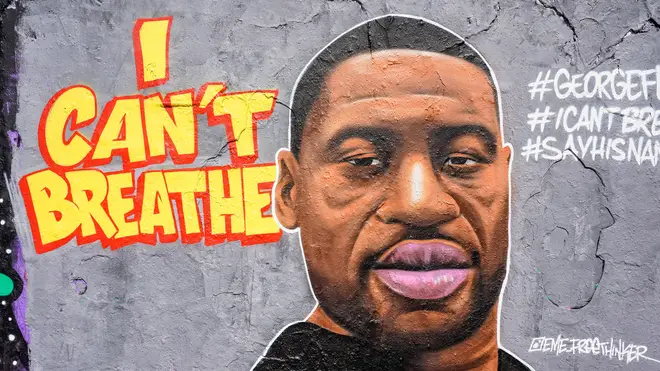
Matthew Wright 7am - 10am
16 July 2020, 14:45

Police body camera footage has revealed George Floyd's last words were "I can't breathe" as pleaded with officers in the minutes before his death.
The footage has not been publicly released but has been seen by several US news outlets, which describe Mr Floyd sobbing, struggling, and the moment he uttered his last words.
Telling the officers he is "not a bad guy" as they wrestle him into the vehicle, the new footage shows the entire incident from May that led to the 46-year-old's demise.
According to CNN, the videos show officers Thomas Lane and J. Alexander Keung responding to a call about a "fake bill" at a shop in Minneapolis.
Once arriving and speaking to the shop owner, the officers then approach Mr Floyd's car, where he is told: "Put your f***ing hands up right now."

George Floyd laid to rest
Transcripts of the encounter had previously been released, but with the showing of the footage, journalists were able to see in more detail the final moment's of Mr Floyd's life.
What ensued, CNN said, were periods of Mr Floyd sobbing and pleading with the officers, before being forcibly removed from his car.
They then escort him to the police vehicle, handcuff him, and embark in a struggle to get him into the car with one office pushing, and another - on the other side - pulling.
READ MORE: Protesters tear gassed so Donald Trump can have photos taken at church
This, the outlet said, was the first time Mr Floyd can be heard saying he couldn't breathe.
Mr Floyd then fell out of the car before more officers - Derek Chauvin and Tou Thao - arrive and intervene to help with restraints.

George Floyd’s niece delivers passionate speech
Just after 11 minutes into one of the clips, Chauvin's knee is placed on Mr Floyd's neck - in the position that many saw in eyewitness video that circulated after the incident back in May.
According to US broadcasters, Chauvin is soon seen shifting his position, and reportedly appears to increase the pressure on Mr Floyd's neck.
READ MORE: Police officers across the US take a knee to honour George Floyd and the protests
READ MORE: President Trump says New York is 'lost' to 'lowlifes and scum' amid protests
Minutes later, the 46-year-old utters his final words: "Man, I can't breathe."
Paramedics arrive a short while later - where there appears to be a lack of urgency - as Mr Floyd's motionless body is picked up and put into the ambulance.

Mourners honour George Floyd
Chauvin has since been charged with second-degree murder and manslaughter.
The other three officers - Lane, Kueng and Thao - have been charged with aiding and abetting second-degree murder and manslaughter.
The footage was filed a week ago to be used as evidence to try and dismiss charges for one of the officers charged in the case.
It was screen on Wednesday, on the same day that Mr Floyd's family filed a suit against city authorities and the four officers.
They argue that Mr Floyd's rights were violated while he was being restrained, and that the city authorities had been complacent with a culture of using excessive force, racism and impunity in the police department.
Ben Crump, one of the lawyers representing Mr Floyd's family, said the 46-year-old had died because "the weight of the entire Minneapolis Police Department was on his neck."
He added: "The city of Minneapolis has a history of policies, procedures and deliberate indifference that violates the rights of arrestees, particularly black men, and highlights the need for officer training and discipline."
The action brought, he said, would seek to set the precedent "that makes it financially prohibitive for police to wrongfully kill marginalised people - especially black people - in the future."
The judge presiding over the cases against the officers has so far blocked news organisations from publishing the body camera footage; however, many have been able to watch and publish a play-by-play of what they saw.